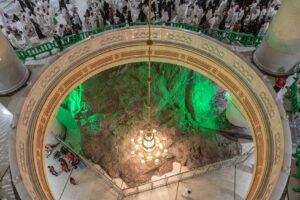Welcome by Safar
for Hajj & Umrah
What is the Umrah?
Umrah is an act of worshipping Allah by entering the state of Ihram, circumambulating the House, running between Safa and Marwa, and having the head shaved or trimmed.
How do I enter into the state of Ihram?
- A Muslim enters into the state of Ihram at the place specified by Sharia, and shall abstain from the Ihram prohibitions
- He shall recite Talbiyah, saying: “Labbayka Allaahumma Labbayk, Labbayka La Shareeka Laka Labbayk. Innal Hamda Wan-ni’mata Laka Wal-Mulk, La Shareeka Lak” (Here I am at your service, o Allah, at Your service! At Your service! You have no partner! I am at Your service! Indeed, all praise and grace belong to You, and so does the supreme authority. You have no partner)
Circumambulation (Tawaf):
- He/she goes to the Haram
- When the Kaaba is to the left, they circumambulate (counterclockwise)
- He begins and ends at the Black Stone
- After completion of the seven rounds, you pray two Rakaah in an appropriate place
Sa’i (between Safa and Marwa):
He/she heads to Safa where he starts Sa’i towards Marwa. Once reaching Marwa, you have completed one round. Crossing the distance back to Safa fulfills the second round, and so on until the seventh round ends at Marwa.
Having hair of the head shaven or trimmed:
- After completing Sa’i, men go to the barber shops to have their hair shaven or trimmed
- Women gather their hair and cut from its ends about (1-2 cm)
- With this act, the Umrah would be completed, marking the end of Ihram
Umrah pilgrims should avoid any conduct that harms others in the Haram, such as jostling, entering crowded places, and reversing the direction of circumambulation. They shall carefully follow the instructions of observers and security personnel.
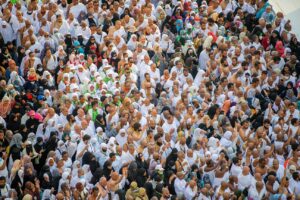
What is the Umrah?
Umrah is an act of worshipping Allah by entering the state of Ihram, circumambulating the House, running between Safa and Marwa, and having the head shaved or trimmed.
How do I enter into the state of Ihram?
- A Muslim enters into the state of Ihram at the place specified by Sharia, and shall abstain from the Ihram prohibitions
- He shall recite Talbiyah, saying: “Labbayka Allaahumma Labbayk, Labbayka La Shareeka Laka Labbayk. Innal Hamda Wan-ni’mata Laka Wal-Mulk, La Shareeka Lak” (Here I am at your service, o Allah, at Your service! At Your service! You have no partner! I am at Your service! Indeed, all praise and grace belong to You, and so does the supreme authority. You have no partner)
Circumambulation (Tawaf):
- He/she goes to the Haram
- When the Kaaba is to the left, they circumambulate (counterclockwise)
- He begins and ends at the Black Stone
- After completion of the seven rounds, you pray two Rakaah in an appropriate place
Sa’i (between Safa and Marwa):
He/she heads to Safa where he starts Sa’i towards Marwa. Once reaching Marwa, you have completed one round. Crossing the distance back to Safa fulfills the second round, and so on until the seventh round ends at Marwa.
Having hair of the head shaven or trimmed:
- After completing Sa’i, men go to the barber shops to have their hair shaven or trimmed
- Women gather their hair and cut from its ends about (1-2 cm)
- With this act, the Umrah would be completed, marking the end of Ihram
Umrah pilgrims should avoid any conduct that harms others in the Haram, such as jostling, entering crowded places, and reversing the direction of circumambulation. They shall carefully follow the instructions of observers and security personnel.

Performing Umrah in Ramadan
Umrah has great virtues at all times. It is one of the deeds that expiate sins, for the Prophet (blessings and peace be upon him) said. Additionally, it has a special virtue during Ramadan.
Reward for performing Umrah in Ramadan
- The Prophet blessings and peace be upon him said: “Performance of Umrah in Ramadan is equivalent to Hajj”, or he said: “Equal to performance of Hajj with me”
- This virtue extends to all the days and nights of Ramadan
- The pilgrim must perform his Umrah at the time allotted to him as shown by the reservations in the official Umrah applications
When you drive for Umrah, park your car in a parking lot in Makkah.
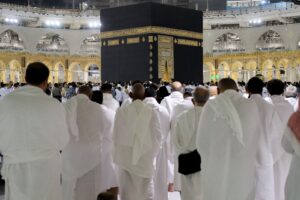
Performing more than one Umrah during the same trip
- Performing the Umrah is one of the best and greatest deeds in the sight of Allah, as the Prophet (blessings and peace be upon him) said: “The performance of one Umrah is an expiation for what was committed between it and the previous. And it is allowed to repeat more than once per year”.
Is it prescribed to perform more than one Umrah during the same trip?
- Some visitors to Makkah are keen to repeat Umrah on behalf of themselves or some of their relatives, for fear that they won’t be able to visit Makkah again. This is permissible unless it causes inconvenience to other pilgrims or it violates the terms and conditions of Umrah’s official applications.
- Once one obtains the necessary permission of the concerned bodies to perform another Umrah shall go to the nearest place outside the Haram, such as the mosque of Aishah (may Allah be pleased with her) in Al Taneem. He/she enters into the state of Ihram from this place, then performs the Umrah.
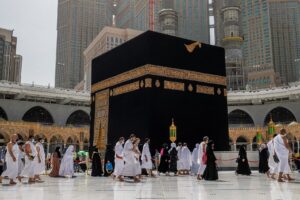
Umrah is a set of rituals of worshipping Allah by entering into the state of Ihram, performing circumambulation of the Kaaba, performing Sa’i between Safa and Marwa, and having one’s hair shaven or trimmed.
It has great stature and virtues, including
- Allah mentioned it along with Hajj and commanded that it be completed and performed in the most perfect manner, for the sake of Allah’s pleasure. The Almighty said: {and perform properly the Hajj and Umrah for Allah}.
- It wipes out sins and reduces poverty and need: the Prophet (blessings and peace be upon him) said: “Perform Hajj and Umrah consecutively; for they remove poverty and sin as the bellows remove impurity from iron”.
- Umrah expiates sins: the Prophet (blessings and peace be upon him) said: “From one Umrah to the next is an expiation for the sins committed between them”.
- Every step in circumambulation is an increase in good deeds and forgiveness of sins: the Prophet (blessings and peace be upon him) said about the virtues of circumambulating the honored House: “Whoever circumambulates the House does not raise a foot or put down the other, except that Allah will write down for him a good deed, erase for him a sin and raise his rank”.
- Sa’i between Safa and Marwa is a reason why Allah will be thankful and rewarding to His servant: after mentioning Sa’i between Safa and Marwa, Allah informed us that He fully knows His servant’s work and that He will reward the servant for the deed and good work. He said: “And who volunteers good, Allah is All-grateful, All-knowing”.
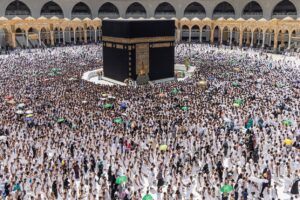
Allah singled out Makkah and honored it over all parts of the world. One of the greatest signs is that it is His sanctuary.
What is the meaning of ‘Haram’ (Sanctuary)?
- It is a place in which certain things, allowed elsewhere, are prohibited out of veneration and reverence for the One Who prohibited it. Allah the Exalted said: {and who observes the sanctity of the sites ordained by Allah, it will be good for him in the sight of his Lord}.
- Allah has chosen this land and made it sacred, forbidding in it what He permitted in other places, and singling it out with virtues and merits that are not found in any other place. Its sanctity and stature date back to the very first beginning of the entire universe.
- Allah has made this land into a Sanctity and assigned to it a very special rank on the day this universe was created. It will remain so until the end of time. The Prophet (blessings and peace be upon him) said: “Allah has made this town a sanctuary from the day He created the heavens and the earth. So, it is a sanctuary by Allah’s decree till the Day of Resurrection”.
What does Sanctity mean to me?
- You are now in a place that Allah singled out, honored, and sacralized before He even created humans. He ordered Abrahim, peace be upon him, to raise the foundations and build the House (Kaaba) before even a single soul lived in Makkah, and chose it to be the qiblah and guidance for the whole world. Allah the Exalted said: {The first House (of Prayer) established for mankind is the one at Bakkah (Makkah): a blessed place, guidance for all worlds (of people and jinn)}.
- You are in a place where the reward for a good deed is multiplied, and where sin is not like a sin in any other place.
- Allah commanded His noblest humans, Abrahim and Ismail, peace be upon them, and then Muhammad (blessings and peace be upon him), to purify, build and take care of the Kaaba.
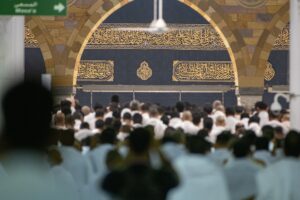
Honorable Makkah is the best place on earth and the most beloved place to Allah and His Messenger.
- Allah chose it for the rituals of Hajj and made visiting it an act of worship by which ranks are raised and bad deeds are erased. The Prophet (blessings and peace be upon him) said: “By Allah, you are the best part of Allah’s earth and the part dearest to Him”.
- It is the place where the first House on earth for the worship of Allah alone was established. Allah the Exalted said: {The first House (of Prayer) established for mankind is the one at Bakkah (Makkah): a blessed place, guidance for all worlds (of people and jinn)}.
- Makkah attained that privilege and position in the first moments of creating the universe. The Prophet (blessings and peace be upon him) said: “Allah made this town sacred on the day He created the heavens and the earth, so it is sacred by the sanctity conferred on it by Allah till the day of resurrection”.
- Muslims from all parts of the world turn toward it five times a day in worship to their Lord, to strengthen their unity and brotherhood. Allah the Exalted said: {We have seen you (O Muhammad), turning your face over and over again towards Heaven}. Now, therefore, We turn you towards the Qiblah that you like best: so turn your face towards the Sacred Mosque. Henceforth, wheresoever you may be, turn your face at prayer towards it.
- For Muslims, Makkah is a Qiblah, guidance, blessing, and grace around which their lives revolve. It is necessary that we thank Allah for this great blessing. Allah the Exalted said: {Allah has appointed the Kaaba, the Sacred House, as a means of support for mankind, and the Sacred Month, the offerings, and the garlands}. That is so that you may know that Allah knows whatsoever is in the heavens and the earth and that Allah is Knower of all things.
It is the sanctuary of Allah, Who honored it and singled it out with the greatest characteristics.

Best time to perform Umrah
A Muslim may perform Umrah at any time. However, there are important criteria for determining the appropriate time for Umrah for each person:
- It is better for the pilgrim to choose the less crowded times so that they can perform the rituals of Umrah, go near the Haram, and pray there with ease.
- There is a special merit for Umrah in the month of Ramadan. The Prophet’s blessings and peace be upon him said: “Performance of Umrah during Ramadan is equal to Hajj”, or he said: “Equal to the performance of Hajj with me”.
- Pilgrims must perform Umrah at the time allotted to them, according to their reservations on the official Umrah apps.
- Umrah is not allowed during the Hajj season, for those who do not intend to combine it with Hajj, to keep the Sacred sites available for pilgrims, because they are more deserving of those sites than others at that time.
Those entering the Kingdom on any type of visa can go to Makkah to perform Umrah after making a reservation through the Nusuk app.

- You can get a trolley to carry your luggage
- There are trolley attendants to load and unload your luggage for a specified fee
- The Hajj missions arrange pilgrims’ exit from the airport in coordination with the concerned airport authorities, determine the bus stop where they are helped to board and their luggage get transferred
To go through the airport customs smoothly, using the relevant declaration form disclose the following:
- Gifts in commercial quantities i.e. sums exceeding SAR 3,000
- Any amounts exceeding SAR 60,000
To guarantee convenient arrival and departure of Hajj and Umrah pilgrims, King Abdulaziz International Airport in Jeddah provides the best services at its various facilities during Hajj and Umrah seasons.

- You can get a trolley to carry your luggage
- There are trolley attendants to load and unload your luggage for a specified fee
- The Hajj missions arrange pilgrims’ exit from the airport in coordination with the concerned airport authorities, determine the bus stop where they are helped to board and their luggage get transferred
To go through the airport customs smoothly, using the relevant declaration form disclose the following:
- Gifts in commercial quantities i.e. sums exceeding SAR 3,000
- Any amounts exceeding SAR 60,000
To guarantee convenient arrival and departure of Hajj and Umrah pilgrims, King Abdulaziz International Airport in Jeddah provides the best services at its various facilities during Hajj and Umrah seasons.

If you come to Makkah to perform Umrah on your own or rented car:
- Remember that you cannot drive in Makkah neighborhoods during the Hajj season and in the last ten days of Ramadan as this restriction is imposed to prevent traffic jams
- You will be asked to park your car in a parking lot in the Holy Capital (Makkah)
Car parking in Makkah
- Al-Haramain High Express Railway station parking lot
- Az-Zaher Parking
- Keddi Parking
- Al-Jamarat Parking
- Ar-Rusaifah Parking
- Duqm Al-Waber Car Parking
- Prince Mit’ib Rd. Parking (Refinery tunnels)
Buses are available to transport Hajj and Umrah pilgrims from these parking lots directly to the Grand Mosque.
Before you travel by car, make sure to
- Check and change fluids, if necessary
- Check brakes, lights, and tires
- Take a spare tire
- Take enough rest before and during the trip
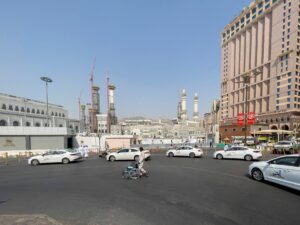
Umrah pilgrims residing in adjacent countries are allowed to enter the Kingdom through land ports on their own or rented cars.
- They may also enter through land ports using means of transportation licensed to external agents only.
Residents and local citizens intending to do Hajj or Umrah can travel by public transport buses.
- They can also drive to Makkah after obtaining a permit to perform Umrah. However, small cars are banned from entering Makkah before the start of the Hajj season and on the last ten days of Ramadan unless they have an official entry permit.
At entrances to Makkah, there are 7 parking lots able to accommodate 50,000 cars of Umrah pilgrims.
You will be asked to park your car in a parking lot in the Holy Capital (Makkah). At these parking lots, buses transport Hajj and Umrah pilgrims directly to the Grand Mosque.
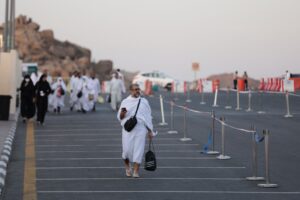
A high-speed train, serving Hajj and Umrah pilgrims, connects Makkah, Madina, and Jeddah Airport.
- The Haramain Express provides fast, safe, and comfortable trips
- Both business and economy class seats are available
- A café that serves food and drinks to passengers throughout the journey is also available
Location of Haramain Express Stations
- Jeddah Airport Station is located inside King Abdulaziz Airport.
- Makkah Railway Station is 3.5 km from the Grand Mosque of Makkah. Buses transport passengers from the Grand Mosque to the train station and vice versa.
- Madina Railway Station is 9 km from the Prophet’s Mosque. Buses transport passengers from the Mosque to the train station and vice versa.
How can I book a Haramain Express ticket?
You can book Haramain Express tickets through:
- Online booking through the website or mobile app
- Train station counters
- Call Haramain Express unified number: 920004433

When you arrive at a Saudi airport
You need to declare in a specific form:
- Any amounts exceeding SAR 60,000, or its equivalent.
- Gifts in commercial quantities exceeding SAR 3,000.
- Do not carry banned items. For details, see the list of banned and restricted items on the Zakat, Tax and Customs Authority website.
Check airport and carrier luggage specifications before your flight, to avoid inconveniences. Make sure to tightly close and wrap your luggage to avoid damage during the flight.
Hajj and Umrah pilgrims are fully responsible for the contents of their baggage and must not accept to carry or keep any items belonging to other people at the airport.

The Kingdom of Saudi Arabia in general, and the Two Grand Mosques in particular, can offer all basic and luxury products and commodities for pilgrims and visitors at competitive prices.
Only carry with you the things you usually need for your travel. Do not take any extras that will burden you unnecessarily.
Remember to take with you
- Your basic official documents: passport, vaccination certificates, necessary permits
- A sufficient quantity of your medications that you need in your travels, a report of your health condition if you suffer from a specific disease and a prescription for special medications
- A wallet with your debit and credit cards and cash you need on your travels
- Your clothes that you need after completing Ihram
- Shoes that are suitable for long walks
- Ihram cloths
- Your mobile phone, mobile charger, a triple-socket charger compatible with Arab Gulf standards (can be purchased at the airport or from retail stores upon arrival), and wireless headphones (if you use them)
- The Quraan or a book that you are keen to read on the trip
Do not take
- Perishable foodstuffs and drinks that require a special method for transportation and storage
- Any items and materials contrary to Islamic culture, such as alcohol, lottery tools, and gambling cards
- Any traditional medicines, nutritional and cosmetic supplements, herbs, or chemicals that are not factory-packed and their ingredients are not written in English
- Electronic cigarettes and their accessories, such as e-liquids, liquid nicotine, and their accessories
- Any items internationally prohibited in travel, such as drugs, weapons, (fake plastic weapons), and flammable materials
Remember
To ensure conforming to airport and airline specifications, check specifications and allowed bag and carton sizes specified by airports and carriers. Also, make sure your luggage is tightly closed and wrapped so that it arrives safely.
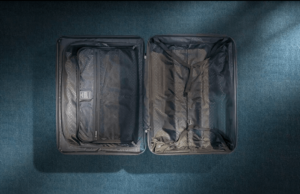
On the spiritual Hajj and Umrah trip to the purest place on earth, there are Miqats (Islamic boundaries Prophet Mohammed Peace Be Upon Him determined for Pilgrims to enter Ihram from), either by land points or parallel to Miqat when arriving by air.
Al-Juhfah
Al-Juhfah is located 182 kilometres (113 miles) northwest of Makkah. This is the Miqat for people intending to perform Hajj traveling from North America, Europe, Turkey, Syria, Egypt, Algeria, Sudan and several other African countries. Pilgrims may also enter into Ihram at Rabigh, a town just to the north of al-Juhfah.
Steps to follow
- Bathing and applying perfume, then men wear Ihram clothing and women enter Ihram wearing their normal clothes.
- Entering into the rituals and uttering the Talbiyah, saying Labbayka Allahuma Umrah (O Allah! Here I am in response to Your call to perform Umrah).
- Talbiyah begins as it was reported from Prophet Muhammad, peace be upon him: “Labbayka Allahumma labbayk, labbayka la sharika laka labbayk. Inna al-hamd wa’l-ni’mata laka wa’l-mulk, la sharika lak (Here I am, O Allah, here I am. Here I am, You have no partner, here I am. Verily all praise and blessings are Yours, and all sovereignty, You have no partner).” Talbiyah continues until pilgrims reach the Kaaba.
- General prohibitions of Ihram: sexual intercourse, marriage contract, hunting, shaving, cutting nails, and using perfume. During Ihram, men are not allowed to cover their heads or wear sewn clothes on any part of the body. Women are not allowed to wear niqab or gloves.
- During Ihram, it is permissible to take a bath, wear glasses, rings and watches, heal wounds, wear a belt or a purse around the body, wear slippers, and carry an umbrella.
- Those who enter Ihram should have good manners, abandon disputes, provide assistance to those who need it, and follow the instructions of the regulatory authorities.
- Important phone numbers related to Hajj and Umrah: (911) for emergency cases and security services, (937) for medical consultations.
On the spiritual Hajj and Umrah trip to the purest place on earth, there are Miqats (Islamic boundaries Prophet Mohammed Peace Be Upon Him determined for Pilgrims to enter Ihram from), either by land points or parallel to Miqat when arriving by air.
Al-Juhfah
Al-Juhfah is located 182 kilometres (113 miles) northwest of Makkah. This is the Miqat for people intending to perform Hajj traveling from North America, Europe, Turkey, Syria, Egypt, Algeria, Sudan and several other African countries. Pilgrims may also enter into Ihram at Rabigh, a town just to the north of al-Juhfah.
Steps to follow
- Bathing and applying perfume, then men wear Ihram clothing and women enter Ihram wearing their normal clothes.
- Entering into the rituals and uttering the Talbiyah, saying Labbayka Allahuma Umrah (O Allah! Here I am in response to Your call to perform Umrah).
- Talbiyah begins as it was reported from Prophet Muhammad, peace be upon him: “Labbayka Allahumma labbayk, labbayka la sharika laka labbayk. Inna al-hamd wa’l-ni’mata laka wa’l-mulk, la sharika lak (Here I am, O Allah, here I am. Here I am, You have no partner, here I am. Verily all praise and blessings are Yours, and all sovereignty, You have no partner).” Talbiyah continues until pilgrims reach the Kaaba.
- General prohibitions of Ihram: sexual intercourse, marriage contract, hunting, shaving, cutting nails, and using perfume. During Ihram, men are not allowed to cover their heads or wear sewn clothes on any part of the body. Women are not allowed to wear niqab or gloves.
- During Ihram, it is permissible to take a bath, wear glasses, rings and watches, heal wounds, wear a belt or a purse around the body, wear slippers, and carry an umbrella.
- Those who enter Ihram should have good manners, abandon disputes, provide assistance to those who need it, and follow the instructions of the regulatory authorities.
- Important phone numbers related to Hajj and Umrah: (911) for emergency cases and security services, (937) for medical consultations.
On the spiritual Hajj and Umrah trip to the purest place on earth, there are Miqats (Islamic boundaries Prophet Mohammed Peace Be Upon Him determined for Pilgrims to enter Ihram from), either by land points or parallel to Miqat when arriving by air.
Qarn Al Manazil
Qarn al-Manazil is located 80 kilometres (50 miles) east of Makkah. This is the Miqat for the people of Najd and for those traveling from countries such as the U.A.E, Oman, Pakistan, Australia, Malaysia, Singapore, etc. It is situated near the city of Ta’if.
Steps to follow
- Bathing and applying perfume, then men wear Ihram clothing and women enter Ihram wearing their normal clothes.
- Entering into the rituals and uttering the Talbiyah, saying Labbayka Allahuma Umrah (O Allah! Here I am in response to Your call to perform Umrah).
- Talbiyah begins as it was reported from Prophet Muhammad, peace be upon him: “Labbayka Allahumma labbayk, labbayka la sharika laka labbayk. Inna al-hamd wa’l-ni’mata laka wa’l-mulk, la sharika lak (Here I am, O Allah, here I am. Here I am, You have no partner, here I am. Verily all praise and blessings are Yours, and all sovereignty, You have no partner).” Talbiyah continues until pilgrims reach the Kaaba.
- General prohibitions of Ihram: sexual intercourse, marriage contract, hunting, shaving, cutting nails, and using perfume. During Ihram, men are not allowed to cover their heads or wear sewn clothes on any part of the body. Women are not allowed to wear niqab or gloves.
- During Ihram, it is permissible to take a bath, wear glasses, rings and watches, heal wounds, wear a belt or a purse around the body, wear slippers, and carry an umbrella.
- Those who enter Ihram should have good manners, abandon disputes, provide assistance to those who need it, and follow the instructions of the regulatory authorities.
- Important phone numbers related to Hajj and Umrah: (911) for emergency cases and security services, (937) for medical consultations.
On the spiritual Hajj and Umrah trip to the purest place on earth, there are Miqats (Islamic boundaries Prophet Mohammed Peace Be Upon Him determined for Pilgrims to enter Ihram from), either by land points or parallel to Miqat when arriving by air.
Yalamlam
Yalamlam is located 100 kilometres (62 miles) south of Makkah. This is the Miqat for the people of Yemen and those coming from the south. Pilgrims traveling from countries such as South Africa, Nigeria etc. will cross this Miqat.
Steps to follow
- Bathing and applying perfume, then men wear Ihram clothing and women enter Ihram wearing their normal clothes.
- Entering into the rituals and uttering the Talbiyah, saying Labbayka Allahuma Umrah (O Allah! Here I am in response to Your call to perform Umrah).
- Talbiyah begins as it was reported from Prophet Muhammad, peace be upon him: “Labbayka Allahumma labbayk, labbayka la sharika laka labbayk. Inna al-hamd wa’l-ni’mata laka wa’l-mulk, la sharika lak (Here I am, O Allah, here I am. Here I am, You have no partner, here I am. Verily all praise and blessings are Yours, and all sovereignty, You have no partner).” Talbiyah continues until pilgrims reach the Kaaba.
- General prohibitions of Ihram: sexual intercourse, marriage contract, hunting, shaving, cutting nails, and using perfume. During Ihram, men are not allowed to cover their heads or wear sewn clothes on any part of the body. Women are not allowed to wear niqab or gloves.
- During Ihram, it is permissible to take a bath, wear glasses, rings and watches, heal wounds, wear a belt or a purse around the body, wear slippers, and carry an umbrella.
- Those who enter Ihram should have good manners, abandon disputes, provide assistance to those who need it, and follow the instructions of the regulatory authorities.
- Important phone numbers related to Hajj and Umrah: (911) for emergency cases and security services, (937) for medical consultations.
On the spiritual Hajj and Umrah trip to the purest place on earth, there are Miqats (Islamic boundaries Prophet Mohammed Peace Be Upon Him determined for Pilgrims to enter Ihram from), either by land points or parallel to Miqat when arriving by air.
Dhat Irq
Dhat Irq is located 90 kilometres (56 miles) northeast of Makkah. This is the Miqat for people intending to perform Hajj travelling from Iraq, Iran, China, Russia etc.
Steps to follow
- Bathing and applying perfume, then men wear Ihram clothing and women enter Ihram wearing their normal clothes.
- Entering into the rituals and uttering the Talbiyah, saying Labbayka Allahuma Umrah (O Allah! Here I am in response to Your call to perform Umrah).
- Talbiyah begins as it was reported from Prophet Muhammad, peace be upon him: “Labbayka Allahumma labbayk, labbayka la sharika laka labbayk. Inna al-hamd wa’l-ni’mata laka wa’l-mulk, la sharika lak (Here I am, O Allah, here I am. Here I am, You have no partner, here I am. Verily all praise and blessings are Yours, and all sovereignty, You have no partner).” Talbiyah continues until pilgrims reach the Kaaba.
- General prohibitions of Ihram: sexual intercourse, marriage contract, hunting, shaving, cutting nails, and using perfume. During Ihram, men are not allowed to cover their heads or wear sewn clothes on any part of the body. Women are not allowed to wear niqab or gloves.
5
During Ihram, it is permissible to take a bath, wear glasses, rings and watches, heal wounds, wear a belt or a purse around the body, wear slippers, and carry an umbrella.
- Those who enter Ihram should have good manners, abandon disputes, provide assistance to those who need it, and follow the instructions of the regulatory authorities.
7
Important phone numbers related to Hajj and Umrah: (911) for emergency cases and security services, (937) for medical consultations.
In Ihram, all people are equal in their dress and appearance. Color and material possessions do not matter at all. After entering the state of Ihram, they proceed to perform the rituals in humility to Allah and supplicating Him alone.
Ihram is the commencement of the rituals of Hajj or Umrah. The rituals are commenced by intending to start Umrah or Hajj and reciting Talbiyah. It is the first pillar of Hajj and Umrah.
A Hajj or Umrah pilgrim may stipulate upon initiating Ihram if he fears his inability to complete his rituals for any reason.
Ihram is the first step in your journey of faith and an act of the heart with which you engage in a great act of worship. Allah commanded us to make our intentions sincere and to perform the rituals for His sake, Glory be to Him, in the most perfect manner. The Almighty said: {Perform Hajj and Umrah for (the sake of) Allah}.
What is Ihram?
- Ihram is entering into the act of worship of Hajj or Umrah. It involves intending to enter into Umrah or Hajj and reciting Talbiyah, which is the first of the pillars of Hajj and Umrah.
- It is the first step in your journey of faith and an act of the heart with which you engage in a great act of worship. It is a great act of worship for which Allah commanded us to make our intentions sincere, and perform its rituals for His sake, Glory be to Him, in the most perfect manner. As the Almighty said: {Perform Hajj and Umrah for (the sake of) Allah}.
- With this intention, things that are permissible before entering into the state of Ihram are now forbidden: such as intercourse, shaving the head, clipping nails, covering the head, wearing sewn clothes for men, etc.
- If you want to engage in the worship of Umrah, you must refrain from the prohibitions of Ihram, and intend to engage in Umrah saying: “Labbayka Umrah”. Then, you begin reciting Talbiyah. If you intend to start performing the Hajj rituals, you shall start with by saying: “Labbayka Hajjan”. Then you begin reciting Talbiyah.
Stipulate a condition in Ihram
Islam is a religion of ease, as Allah Almighty said: {Allah intends for you ease and does not want to make things difficult for you}. One of the manifestations of this facilitation for Muslims in performing acts of worship is taking into account the circumstances that may prevent them from completing the rituals of Hajj or Umrah.
If a pilgrim fears that he will not be able to complete the rituals of Hajj or Umrah for any reason, it is lawful to stipulate a condition while in Ihram.
How to stipulate?
If the pilgrim performing Hajj or Umrah fears that he will not be able to complete his rituals due to a disease or a lawful excuse or for a reason beyond his control, it is allowed for him/her to make exceptions in their utterance of the intention. One does so by saying after saying “Labbayka Umrah” or “Labbayka Hajjan”: “If I’m deterred for any reason, then my place is where You deterred me (this can be said in any language)”. If a pilgrim says this and stipulates a condition, and then something prevents them from completing the ritual, it is permissible for him to leave the state of Ihram without falling under any further obligation.
Who can stipulate a condition?
Whoever fears that one will not complete the rituals for a reason beyond their control, including:
- A woman who is afraid that a legitimate excuse (i.e., the menstrual period) will prevent her from completing her rituals
- A sick person who fears that he will not be able to complete his rituals
Instructions for people in Ihram
You are now performing great worship that you have entered with your intention and Talbiyah. Here are a few important pieces of advice:
- Glorify Allah’s rituals, commands, and prohibitions. Give them their due reverence and respect. The Almighty says: and whoever honors the rites of Allah, indeed, it is from the piety of hearts.
- Avoid all acts that violate or desecrate your Ihram, such as quarrels, raising your voice, and hurting or arguing with others. The Almighty says: Whoever intends to perform Hajj therein, then they should not have sexual relations with their spouse, nor commit sin, nor dispute during Hajj.
- Recite Talbiyah as much as you can, for it is a great remembrance and supplication that is not prescribed except in these times. The Prophet, blessing and peace be upon him, said: “No Muslim recites Talbiyah except that whatever to his right and left but reiterate it: rocks, trees, and hills, to the farthest ends of the earth in each direction, from here and from there.
- Abide by the instructions of the security personnel and mission supervisors, for they are keen to ensure your and other pilgrims’ interests.
- Learn the rules of Hajj and/or Umrah.
- Avoid exposure to direct sunlight and use a sunshade when you go out during the daytime.
Examples of things that may prevent you from performing your Hajj or Umrah rituals
- Illness
- Menstruation
- Emergencies
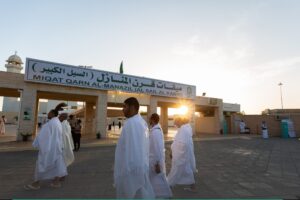
In Ihram, all people are equal in their dress and appearance. Color and material possessions do not matter at all. After entering the state of Ihram, they proceed to perform the rituals in humility to Allah and supplicating Him alone.
Ihram is the commencement of the rituals of Hajj or Umrah. The rituals are commenced by intending to start Umrah or Hajj and reciting Talbiyah. It is the first pillar of Hajj and Umrah.
A Hajj or Umrah pilgrim may stipulate upon initiating Ihram if he fears his inability to complete his rituals for any reason.
Ihram is the first step in your journey of faith and an act of the heart with which you engage in a great act of worship. Allah commanded us to make our intentions sincere and to perform the rituals for His sake, Glory be to Him, in the most perfect manner. The Almighty said: {Perform Hajj and Umrah for (the sake of) Allah}.
What is Ihram?
- Ihram is entering into the act of worship of Hajj or Umrah. It involves intending to enter into Umrah or Hajj and reciting Talbiyah, which is the first of the pillars of Hajj and Umrah.
- It is the first step in your journey of faith and an act of the heart with which you engage in a great act of worship. It is a great act of worship for which Allah commanded us to make our intentions sincere, and perform its rituals for His sake, Glory be to Him, in the most perfect manner. As the Almighty said: {Perform Hajj and Umrah for (the sake of) Allah}.
- With this intention, things that are permissible before entering into the state of Ihram are now forbidden: such as intercourse, shaving the head, clipping nails, covering the head, wearing sewn clothes for men, etc.
- If you want to engage in the worship of Umrah, you must refrain from the prohibitions of Ihram, and intend to engage in Umrah saying: “Labbayka Umrah”. Then, you begin reciting Talbiyah. If you intend to start performing the Hajj rituals, you shall start with by saying: “Labbayka Hajjan”. Then you begin reciting Talbiyah.
Stipulate a condition in Ihram
Islam is a religion of ease, as Allah Almighty said: {Allah intends for you ease and does not want to make things difficult for you}. One of the manifestations of this facilitation for Muslims in performing acts of worship is taking into account the circumstances that may prevent them from completing the rituals of Hajj or Umrah.
If a pilgrim fears that he will not be able to complete the rituals of Hajj or Umrah for any reason, it is lawful to stipulate a condition while in Ihram.
How to stipulate?
If the pilgrim performing Hajj or Umrah fears that he will not be able to complete his rituals due to a disease or a lawful excuse or for a reason beyond his control, it is allowed for him/her to make exceptions in their utterance of the intention. One does so by saying after saying “Labbayka Umrah” or “Labbayka Hajjan”: “If I’m deterred for any reason, then my place is where You deterred me (this can be said in any language)”. If a pilgrim says this and stipulates a condition, and then something prevents them from completing the ritual, it is permissible for him to leave the state of Ihram without falling under any further obligation.
Who can stipulate a condition?
Whoever fears that one will not complete the rituals for a reason beyond their control, including:
- A woman who is afraid that a legitimate excuse (i.e., the menstrual period) will prevent her from completing her rituals
- A sick person who fears that he will not be able to complete his rituals
Instructions for people in Ihram
You are now performing great worship that you have entered with your intention and Talbiyah. Here are a few important pieces of advice:
- Glorify Allah’s rituals, commands, and prohibitions. Give them their due reverence and respect. The Almighty says: and whoever honors the rites of Allah, indeed, it is from the piety of hearts.
- Avoid all acts that violate or desecrate your Ihram, such as quarrels, raising your voice, and hurting or arguing with others. The Almighty says: Whoever intends to perform Hajj therein, then they should not have sexual relations with their spouse, nor commit sin, nor dispute during Hajj.
- Recite Talbiyah as much as you can, for it is a great remembrance and supplication that is not prescribed except in these times. The Prophet, blessing and peace be upon him, said: “No Muslim recites Talbiyah except that whatever to his right and left but reiterate it: rocks, trees, and hills, to the farthest ends of the earth in each direction, from here and from there.
- Abide by the instructions of the security personnel and mission supervisors, for they are keen to ensure your and other pilgrims’ interests.
- Learn the rules of Hajj and/or Umrah.
- Avoid exposure to direct sunlight and use a sunshade when you go out during the daytime.
Examples of things that may prevent you from performing your Hajj or Umrah rituals
- Illness
- Menstruation
- Emergencies

- Everyone coming to Makkah for Hajj or Umrah must enter into the state of Ihram from the Miqat specified for them.
- Those traveling by plane to Jeddah shall enter into the state of Ihram on the plane when one is in line with the Miqat.
- On a plane, the alignment with the Miqat is usually announced well prior to reaching it, and then there will be an announcement again when the plane is actually aligned with the Miqat.
- A person who wants to perform Umrah must prepare his Ihram clothes and remove what is forbidden to him while in Ihram well before the announcement of the plane’s alignment to a Miqat, so as to avoid crowding at the toilets on airplanes.
- When the actual alignment with the Miqat is announced, he implies the intention of Hajj or Umrah. Then, he utters what he intended, saying: “Labbayka Hajjan” or “Labbayka Umrah” and then begins reciting Talbiyah.
- He has to be alert and stay awake in order to intend to enter into Ihram over the Miqat. If he fears that he may fall asleep, then he can enter into Ihram before reaching the Miqat.
- If he suspects or has been informed that the flight crew will not alert them to the alignment with the Miqat, he can enter into Ihram before arrival as a precaution, e.g., half an hour before the arrival time.
If the flight crew announces alignment with the Miqat, you should intend to enter into Ihram for Hajj or Umrah and vocally utter the type of ritual you intended to perform. “Allaahumma Labbayka Hajjan” or “Allaahumma Labbayka Umratan”.
As a precaution, you may enter into the state of Ihram onboard before aligning with the Miqat
- If you fear that you will fall asleep or forget
- If you suspect that the flight crew will not announce alignment with the Miqat
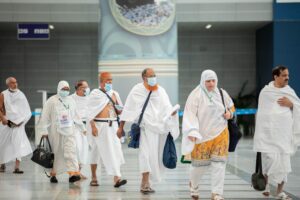
Talbiyah is the reiteration of “Labbayk Allaahumma Labbayk, Labbayka Laa Shareeka Laka Labbayk. Innal Hamda Wan-ni’matah Laka Wal-Mulk, Laa Shareeka Lak (Here I am at your service, o Allah, at Your service! At Your service! You have no partner! I am at Your service! Indeed, all praise and grace belong to You, and so does the supreme authority. You have no partner”.
With this, the Muslim declares at the beginning of his Hajj and Umrah that he has come in response to and in compliance with the command of Allah Almighty to perform that ritual. Although this is the custom of a Muslim in all his deeds of worship, in Hajj and Umrah he announces and repeats it in order to get himself used to these great meanings.
What is the meaning of the words of Talbiyah?
Its meaning is: O Allah, we have come, answering Your call to perform Hajj time after time, acknowledging You in monotheism and worship, and acknowledging Your grace and the perfection of Your supreme authority.
Talbiyah is the majestic motto of the pilgrims. It declares servitude and obedience to the Creator and the Bountiful Giver. Glory be to Him.
Whispering and Saying loudly Talbiyah:
- For men, it is Sunnah to raise their voices when reciting Talbiyah. The Prophet (blessing and peace be upon him) said: ‘Jibreel came to me and ordered me to order my Companions to raise their voices when reciting Talbiyah.
- It is prescribed for women to lower their voices when reciting Talbiyah.
When does Talbiyah begin? When does it end?
Starting Talbiyah
The time for Talbiyah begins the moment of initiating Ihram. A Hajj or Umrah pilgrim entering into Ihram shall do the following:
- He shall intend performing Hajj, Umrah, or both.
- He shall say: “Labbaik Hajjan”, “Labbaik Umrah”, or “Labbaik Hajjan Wa-Umrah”. By uttering these words, one enters the state of Ihram.
- He shall repeat the following Talbiyah loudly: “Labbayk Allaahumma Labbayk, Labbayka Laa Shareeka Laka Labbayk. Innal Hamda Wan-ni’Matah Laka Wal-Mulk, La Shareeka Lak. Here I am at your service, O Allah, at Your service! At Your service! You have no partner! I am at Your service! Indeed, all praise and grace belong to You, and so does the supreme authority. You have no partner”.
Concluding Talbiyah
- In Umrah, Talbiyah ends when you see the House or begin Tawaf
In Hajj, Talbiyah ends when you stone Jamrat Al Aqabah
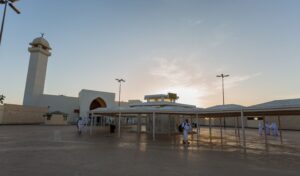
The problem of intertrigo and body fold rush is common among pilgrims performing Hajj and Umrah, especially among people with obesity and diabetes. The skin becomes infected due to friction and lack of underwear. Rush occurs in folds where two layers of the skin meet, such as:
- The groins
- Armpits
- Under the breasts
This is sometimes accompanied by painful itching.
Prevention
- Take care of your personal hygiene
- Keep body folds such as thighs and armpits well ventilated
- Apply ointments on the body before walking
- When infected, wash the area well before applying medications such as healing ointments
Precautions
- Wearing clean clothes will prevent many health problems such as irritating skin abrasions
- Diabetics should be aware that peeling of the skin may increase due to crowding, excessive sweating, and abnormal blood sugar levels

Why are there special sites (Miqats) for entering into Ihram?
Out of respect for the Honored House of Allah and the rituals of Hajj and Umrah, the Messenger of Allah (blessings and peace be upon him) specified places before reaching Makkah, where pilgrims enter into the state of Ihram, and from which they begin reciting their Talbiyah before reaching the Haram.
After specifying the exact locations of these places, the Prophet (blessings and peace be upon him) said: “These Miqats are for the people at those very places and those who come through those places with the intention of performing Hajj and Umrah”.
These sites differ in their distance from and proximity to the Grand Mosque, depending on which direction you come from.
Pilgrims who live beyond those Miqats are obliged to enter into Ihram at the Miqats or any adjacent or parallel points on the way, whether they travel by air or by land. They should not go beyond them without entering the state of Ihram.
Determining your Miqats
The reason why Miqats are prescribed is to venerate the Grand Mosque of Makkah. Miqats depend on the whereabouts of the person who intends to perform Hajj or Umrah; i.e., whether they are in Makkah, somewhere between Makkah and the Miqat, or beyond the Miqat. All of that would be explained as follows:
Determining your Miqats
Those who are in Makkah:
- They enter into the state of Ihram for Umrah from the nearest place outside the Haram, such as Masjid Aisha in Al Taneem. As for Hajj, pilgrims shall enter into the state of Ihram from the very place they are in.
Those somewhere between Makkah and the Miqats:
- They enter into the state of Ihram for Hajj or Umrah from the very place they are in, like in the case of someone living in Jeddah or Bahrah.
Those beyond the Miqats:
- They shall enter into the state of Ihram for Hajj or Umrah from one of the five Miqats or from a parallel point.
A pilgrim or a visitor living far from Makkah is obliged to enter the state of Ihram at one of these five Miqats or a parallel point on their way regardless of the travel means, by a plane or by a vehicle. They may not go beyond the Miqat without entering the state of Ihram.
Miqats for Ihram
Miqats are the places from which a pilgrim who wants to perform Hajj or Umrah enters into Ihram. A pilgrim seeking to perform Hajj or Umrah must not pass from one of these Miqats without entering the state of ihram. They are:
- Dhul-Hulaifa: the Miqat for the people of Madina. It is 420 km from Makkah.
- Al-Juhfah: the Miqat for the people of the Levant and those on their way. It is 187 km from Makkah. Today, people enter Ihram in Rabigh, which is 204 km from Makkah.
- Qarn Al-Manazil: the Miqat for the people of Najd and those on their way. It is 94 km away from Makkah.
- Yalamlam: the Miqat for the people of Yemen and those on their way. It is 115 km away from Makkah.
- Dhat Irq: the Miqat for the people of Iraq and those on their way. It is 92 km away from Makkah.

Several acts are prescribed before intending to enter into the state of Ihram:
Taking a full bath (Ghusl) or performing the ablution (Wudoo).
- It is prescribed to take a full bath (Ghusl) or perform ablution (Wudoo) before the pilgrim intends to enter into Ihram. This is a Sunnah for males and females, in all circumstances; yet, it is not an obligatory Ghusl. If someone cannot take a bath, they can perform a normal ablution (Wudoo) instead.
Taking a bath at home
- A person who cannot perform a full body wash (Ghusl) at the miqat, like a person on a plane, can perform a full body wash for Ihram at home before going to the airport. If the plane is parallel to the miqat.
- Being in a state of ritual purity is not an obligatory condition for valid Ihram, but is recommended.
- Personal hygiene, such as clipping nails and removing armpit hair and the like, is permissible in all cases, especially before entering into the state of Ihram because it is forbidden to remove them while in Ihram.
Entering into Ihram after performing a prayer
- It is prescribed for a person in Ihram to enter Ihram after a prayer. If it is time to perform obligatory prayers, one needs to pray first and then intend Ihram. If this is not the case, it is right to perform ablution and pray two Rakaah, after which the pilgrim enters into Ihram and recites Talbiyah.
The Prophet (blessings and peace be upon him) said: “A messenger from my Lord visited me while I was in the Aqiq (valley)”, and said to me, “Offer prayer in this blessed valley and say: (performance of) Umrah and Hajj together”.
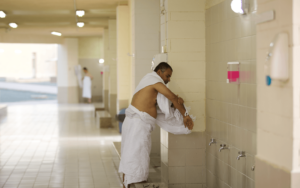
Hajj and Umrah are unique moments during which pilgrims give up their prestige and money. All people are equal in their dress and appearance. They are not separated by color or material possessions. They gather on the same spots, praying to Allah and supplicating to Him, for Glory be to Him, the Rich and all His servants stand in need for Him.
What should a person wear to enter into Ihram?
A pilgrim must take off his usual clothes, including:
- Head coverings, such as hats, turbans, etc.
- The usual, sewn clothing, such as shirts, pants, socks, gloves, etc.
- Shoes around the entire foot and ankles
- He wears a cloth that surrounds the lower part of his body, and another for the upper part
- It should be white
- He shall wear appropriate sandals that do not cover the entire foot
The following items may be worn be during Ihram:
- A buckle or belt that he wraps around his waist to keep his Izaar (waist-wrapper or lower garment) from falling, and in which he can put his belongings, phone, and money
- Watches and rings
- Plasters and bandages to cover wounds
- Umbrellas and all head coverings that do not touch the head
How to wear the Ihram?
A man’s Ihram consists of a waistcloth that covers the lower part of his body and another cloth that covers the top of the body. In some Muslim regions, people are accustomed to wearing these in an appropriate way because it is their traditional dresses. On the other hand, some people find it very difficult to wear the Ihram in an appropriate manner that ensures it is:
- Sufficiently covering the body
- Comfortable convenient to walk freely
- It is fixed firmly and does not hang or fall

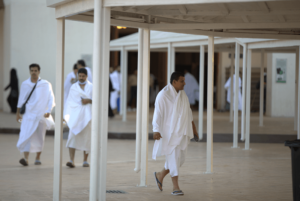
Hajj and Umrah are two of the best acts of worship for both men and women. The Prophet (blessings and peace be upon him) said: “You (women) should engage in a jihad in which there is no fighting; Hajj and Umrah”.
When entering into Ihram, a woman can choose what she wants to wear. She can enter into the state of Ihram in whatever color of clothes she likes provided that they are
- Loose, and cover the body without impeding movement
- Free from apparent adornments that may tempt men
Prohibitions of Ihram for Women
A woman in Ihram is forbidden from the following:
- Covering the face and wearing the Niqab, yet, if she is in the presence of non-Mahram men, she may cover the face
- Wearing gloves
The following are not prohibited during Ihram
- Wearing glasses, rings, and watches
- Plasters and bandages to cover wounds
- Covering a woman’s face when she fears temptation
Note
Women should choose loose, wide and covering clothing that is breathable, especially during summer hot days.
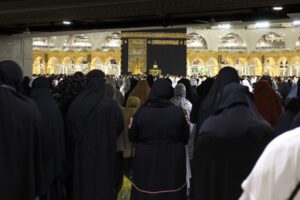
In essence, these are permissible but are restricted in Ihram as part of worship, so that people show their need for their Creator and Master.
Some of these prohibitions apply to both men and women, some apply to each separately.
General Ihram prohibitions for men and women
- Sexual intercourse: it is forbidden for both men and women
- Concluding a marriage contract
- Killing game
- Shaving the head or clipping nails
- Wearing perfume
Men-only Prohibitions
- Covering the head with something directly touching the head such as a hat or a turban
- Wearing the usual sewn clothes, such as shirts, pants, underwear, socks, gloves and shoes around the entire foot up to the ankles
Women-only Prohibitions
- Covering the face and wearing the niqab. However, a woman fearing sedition in the presence of non-mahram men may cover her face
- Wearing gloves
Things permitted while in Ihram
- Having a bath
- Wearing glasses, rings and watches
- Dressing wounds with plasters or bandages
- Wearing a belt and wallet around the body
- Carrying an umbrella to protect yourself against the sun or rain
- Wearing open shoes
- Women covering their face when they fear temptation
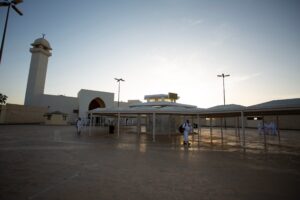
- Parents can take their children of all ages to perform prayers in the Grand Mosque of Makkah
- They must obtain Umrah permits for children over 5 years old through the Nusuk app
- They shall make sure that their child has a card or bracelet bearing his/her name and the parent’s phone number
- They shall always hold their child’s hand, and shall not move away from them so that they won’t get lost
- They shall also make sure that their children do not disturb worshipers
Drifters Care Center
The Drifters Care Center receives children who get lost in the Grand Mosque and hands them over to their families. It is supervised by the security force of the Grand Mosque of Makkah.
To ensure the safety and well-being of your child in Haram, avoid getting them into crowds.
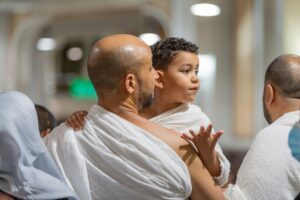
- Parents can take their children of all ages to perform prayers in the Grand Mosque of Makkah
- They must obtain Umrah permits for children over 5 years old through the Nusuk app
- They shall make sure that their child has a card or bracelet bearing his/her name and the parent’s phone number
- They shall always hold their child’s hand, and shall not move away from them so that they won’t get lost
- They shall also make sure that their children do not disturb worshipers
Drifters Care Center
The Drifters Care Center receives children who get lost in the Grand Mosque and hands them over to their families. It is supervised by the security force of the Grand Mosque of Makkah.
To ensure the safety and well-being of your child in Haram, avoid getting them into crowds.

Public transport buses are available and can be used after buying a ticket. These air-conditioned buses transport Umrah pilgrims at reasonable prices.
During the Hajj season, each Hajj mission provides buses to transport the pilgrims from King Abdulaziz International Airport in Jeddah to Makkah.
Hajj missions arrange the exit of pilgrims from the airport in coordination with the concerned airport authorities, determine the bus stop to transport passengers, arrange their boarding and transfer their luggage.

Hajj and Umrah pilgrims may bring and use their own wheelchairs in the Grand Mosque of Makkah provided that they enter through wheelchair gates.
Wheelchair pushing service is available in the Grand Mosque.
Both hand-driven and motorized wheelchairs are available.

Pilgrims lose large amounts of fluid through sweating, which may cause sunstroke.
How do I protect myself from a sunstroke?
- Drink more water and fluids to prevent dehydration
- Don’t expose yourself unnecessarily to the heat of the sun
- When you go out during the day, avoid direct exposure to sunlight, and use a light-colored umbrella
- You must cover your body, except for the parts the pilgrim is commanded to uncover
- At night get as much sleep as possible, and avoid staying up late because insufficient sleep causes stress and weakens the immunity
What should I do when someone has a sunstroke?
- Report the case to the nearest security officer or a campaign official
- Immediately call an ambulance
-
Provide first aid as follows:
- Move the patient to a cool place
- Remove outer clothing
- Cool the body with water
- Expose the body to an air source
- Give the patient some fluids

Many gates lead to the courtyard of the Grand Mosque. Each gate has a specific number.
Above each gate, a light panel, recognizable from a distance, displays either an entry or exit sign.
The five main gates of the Grand Mosque:
- King Abdulaziz Gate: No. 1 in the Western Square
- Bab Safa Gate: No. 11 in the direction of Sa’i walkway (Masaa)
- Bab Al Fatah Gate: No. 45 in the North Square
- Bab Umrah (The Umrah) Gate: No. 62 in the North Square
- King Fahd Gate: No. 79 in the Western Square
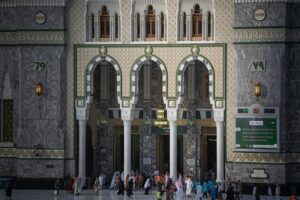
Special gates are allocated to Umrah pilgrims in each season to regulate their entry to the Haram.
These gates differ from the gates allocated for the entry of worshippers in the Grand Mosque of Makkah.
If you are performing Umrah, ask the security personnel about Umrah gates.
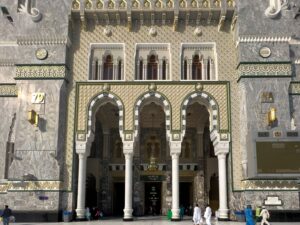
When you leave the airport, you will find many taxis to travel to the Grand Mosque of Makkah.
You can also hire a private taxi from the taxi service offices in the airport arrival lounge.
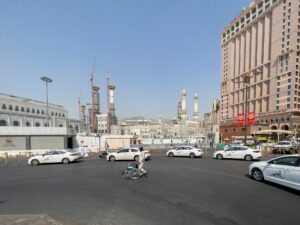
Banned items in the Grand Mosque include
- Foods and drinks (except for coffee, dates, and water)
- Sharp tools
- Flammable liquids
- Large bags and baggage
- Baby carriages
Pilgrims should not leave their luggage and personal belongings at the gates.
They may lodge their belongings in the safe boxes in the outer courtyards of the Haram.
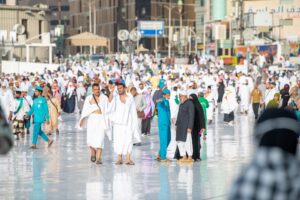
The circumambulation building comprises the following
- The circumambulation courtyard
- Ground floor
- 1st floor
- The mezzanine floor for wheelchair users on the first floor
- The roof
Capacity of the circumambulation building
- The circumambulation courtyard accommodates 30,000 circumambulators per hour
- Total capacity of all floors: 107,000 circumambulators per hour
These floors are accessed through special paths determined by security personnel. Hajj and Umrah pilgrims should cooperate with them and follow their instructions.

The circumambulation building comprises the following
- The circumambulation courtyard
- Ground floor
- 1st floor
- The mezzanine floor for wheelchair users on the first floor
- The roof
Capacity of the circumambulation building
- The circumambulation courtyard accommodates 30,000 circumambulators per hour
- Total capacity of all floors: 107,000 circumambulators per hour
These floors are accessed through special paths determined by security personnel. Hajj and Umrah pilgrims should cooperate with them and follow their instructions.

Idtibaa is a Sunnah way of wearing the Ihram robe for men when performing the circumambulation (Tawaf).
- It is Sunnah for a man during the circumambulation for Umrah to uncover his right shoulder, following the example of the Prophet (blessings and peace be upon him).
- It came into practice when Quraish people said about the Prophet and his companions: “A people who have been weakened by disease will come to you”, so the Messenger of Allah (blessings and peace be upon him) and his companions wanted to show their strength and briskness.
- Then, the Messenger of Allah (blessings and peace be upon him) and his companions continued doing so. Muslims shall follow the example of the Messenger of Allah (blessings and peace be upon him) and show their strength and briskness in turning to his Lord.
- Idtibaa is prescribed in the circumambulations of Umrah and arrival (Tawaf Al Qudoom), but it is not prescribed in Tawaf Al Ifaadah (for Hajj) or the absolute supererogatory circumambulation for non-Muhrim.
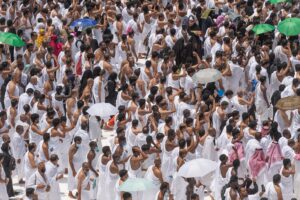
Al Ramal (walking fast during circumambulation).
It is Sunnah of the Messenger of Allah (blessings and peace be upon him) to walk briskly during the circumambulation.
It is prescribed for men, whenever possible, to walk quickly in small steps in the first three rounds, following the example of the Messenger of Allah (blessings and peace be upon him), while walking during the remaining four rounds is doing at a normal pace.
- To walk quickly in small steps is different from jogging.
- This Sunnah applies to men only.
- It is prescribed to perform Ar-Ramal and walk briskly in the circumambulation of ‘Umrah and the circumambulation on arrival (Tawaf Al Qudoom), but it is not prescribed for the Tawaf Al Ifaadah (Hajj) and the farewell circumambulation (Tawaf Al Wadaa), nor in the supererogatory circumambulation for non-Muhrim.
- In the case of crowding, one needs to take extra care so as not to inflict harm upon himself or others. If circumambulating with his family, he ought not to cause difficulty for them.
Ramal (fast circumambulation) is Sunnah for men, but not for women.

The circumambulation (Tawaf) is one of the pillars of Umrah and is an act of worship in which, by directing our hearts and bodies to Allah, we are humbled confess our needs to the Almighty. In this act of worship, the servant circumambulates the House of Allah (the Kaaba), worshipping the Lord of the House and drawing close to Him as He has prescribed.
Description of Circumambulation
- Pilgrims performing Hajj or Umrah start circumambulation from the corner where the Black Stone is located. On the upper floors, a green sign indicates this position.
- Pilgrims performing Hajj or Umrah should say Takbir in each round when they are parallel to the Black Stone, but it is not a condition that Takbir should be uttered exactly at this point. It is not the case that it is not valid to say Takbir before or after it; rather one can do Takbir somewhere near this point. So, if the pilgrim sees that he has already passed the Black Stone, he can still utter Takbir.
- When uttering Takbir, a pilgrim shall point with their hand at the Black Stone, and then start circumambulating with the Kaaba to his left (counterclockwise).
- Kissing the Black Stone is a Sunnah for those who are able to do so, but this is difficult during the Hajj season crowded days.
- One continues circumambulation, supplicating Allah and praying humbly to Him.
- If one reaches the Yemeni corner, which precedes the Black Stone, it is desirable to wipe over it if possible. During the Hajj season, this will be difficult.
- The round ends at the corner of the Black Stone, which marks the start place. Here, he/she points with their hand and utters Takbir.
- One repeats this until completing seven rounds.
Circumambulation Instructions
For a safe and Ideal circumambulation:
- Walk on without stopping in the circumambulation courtyard to prevent crowding and jostling
- Do not reverse the direction of circumambulation, whatever the reasons
- The phrase Allahu Akbar (Allah is the greatest) inscribed on the Kaaba cloth over the Black Stone indicates the corner of the Black Stone
- A green light sign in the upper floor circumambulation tracks indicates the alignment of the Black Stone
Visitors performing supererogatory circumambulation shall follow instructions and regulations of the times and places of circumambulation and give the opportunity to Hajj and Umrah pilgrims as a priority shall be given to Hajj and Umrah pilgrims.
When you circumambulate the Kaaba, avoid crowded places. Help reduce crowding through proper entry and exit from the Mataf (circumambulation area) and by praying away from the circumambulators.
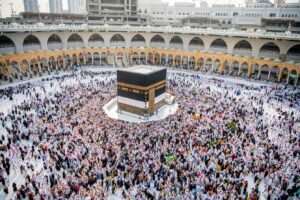
It is permissible for a person who is unable to walk or who feels ill or tired to circumambulate riding, but he must remain awake and attentive because he is doing an act of worship. He should fill his time with the remembrance of Allah and supplicating to Him.
Various types of wheelchairs are available for circumambulation in the Haram
Private wheelchair for the pilgrim
- Whoever has a wheelchair is allowed to do so, provided that he enters from the place designated for the vehicles.
Free wheelchairs
- Free wheelchairs are available for a pilgrim performing Hajj or Umrah if he has someone to push him in Sa’i.
These wheelchairs can be accessed at
- The Eastern square (Mass Transit) Entrance
- The Southern Square (next to the endowment of King Abdulaziz, may Allah have mercy on him)
- The Western Square (Shubaikah Gate)
Wheelchair push service
- These are wheelchairs in which the pilgrim is pushed by one of the young men who are trained to do so.
Electric wheelchairs
- These are safe electric wheelchairs that are easy to drive and control for circumambulation and Sa’i. There are two types: single and double
Places where this service can be found
- Electric wheelchairs are located on the first Mezzanine floor of circumambulation and Sa’i
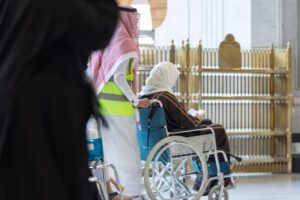
The Kaaba is the Sacred House of Allah and the greatest building for Muslims. It enjoys great prestige and a glorious history. It was built by Abraham and his son, Ismail, peace be upon both of them.
A Muslim may perform obligatory or supererogatory prayers inside the Kaaba.
It is the first house that Allah placed on earth so that mankind may worship Him alone, without ascribing any partner to Him. The Almighty says: {The first House (of Prayer) established for mankind is the one at Bakkah: a blessed place and a guidance for the worlds}. It is the Qiblah of Muslims and the thrust of their hearts. It is the only structure that they circumambulate in worship to Allah.
The Kaaba has several features that can be observed during circumambulation:
Al Hatim (Hijr Ismail)
- It is an open semi-circular space next to the Kaaba. A portion of it was part of the Kaaba. Prayer inside this enclosure is equivalent in reward to prayer inside the Kaaba.
Door of the Kaaba
- The door of the Kaaba is located on the eastern side of the Kaaba. Today it is made of pure gold. It is 222 cm above the ground
- Width: 171 cm
- Length: 318 cm
- The Kaaba is covered with a special cloth called the “Sitarah” (curtain)
- The current door was made during the reign of King Khalid bin Abdulaziz, may Allah have mercy on him
- It is made of 280 kg of pure gold
Al Multazam
- It is the eastern wall or part of it. It is located between the Black Stone and the door of the Kaaba.
- Iltizam (holding) means that a person presses his chest, face, arms, and hands against this wall, and supplicates Allah Almighty. This may be difficult, even impossible, during crowded seasons.
The Roof Gutter
- It is the part installed on the surface of the Kaaba to drain water to Hijr Ismail. It is made of pure gold with a pure silver lining.
Shazrawan
- It is a supporting structure for the Kaaba
- It encompasses it like a dress
- It is not part of the Kaaba
- It was originally built to strengthen the structure of the Kaaba and protect it from torrential rains
- It has been preserved over the centuries
- Today, it is covered with white marble
The Black Stone
- The Black Stone came from Paradise, as the Prophet, blessing and peace be upon him, said.
- It marks the starting and concluding points of one’s circumambulation.
- After a part of the building of the Kaaba was demolished by rain, the Prophet, blessings and peace be upon him, put the Black Stone back in its place when people differed over who would put it in its place.
- It is situated in the southeast corner of the Kaaba.
- It is enclosed by a silver frame to protect it.
- It is 1.5 m above the ground.
- It is prescribed to kiss the Black Stone, if possible, following the example of the Prophet (blessings and peace be upon him). Avoid jostling and crowding at the stone.
- The Black Stone is described as black because of its color.
- The Prophet, blessings, and peace be upon him, said: “The Black Stone descended from Paradise. It was whiter than snow but was blackened by the sins of the polytheists”.
The Yemeni Corner
- The Yemeni Corner is one of the four corners of the Honored Kaaba. It is called “Yemeni” because it faces Yemen. This corner and the Black Stone are called “The two Yemeni corners”.
- It is Sunnah for a circumambulator to wipe over it, if possible, without kissing it. However, if he is unable to do so, then it is not prescribed to point at it or utter takbeer when in alignment with it.
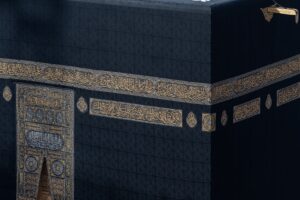
Zamzam water is one of Allah’s blessings on Makkah and its visitors. Allah bestowed it on Ismail, peace be upon him, and his mother Hagar, when Abrahim, peace be upon him, left them in Makkah in response to Allah’s command to him. Then, he supplicated to his Lord, saying: {Our Lord! verity I have settled some of my posterity in an uncultivable valley near unto Your Sacred House. Our Lord! that they may establish the prayer; so incline some hearts of men that they may yearn toward them, and provide them with fruits in order that they may be thankful}.
Therefore, Allah caused that sweet water to spring from under the feet of the child and granted it characteristics and advantages incomparable to any water on earth, to honor Abrahim, his son, and his wife, and after them the nation of Muhammad (blessings and peace be upon him).
Zamzam water in the two Grand Mosques
- Zamzam water is supplied in drinking water containers throughout the Grand Mosque of Makkah and the Prophet’s Mosque, in two conditions: cooled, which is usually offered, and uncooled, which is marked.
- Plastic cups are available for drinking. These are single-use cups. New cups are stacked on the right-hand side of each container and shall be disposed of in the bin on the left-hand side.
- The water staff periodically refills the containers, so moving these containers from their place will disrupt refilling work.
- These containers are prepared for drinking only. Using them for ablution or taking water outside the Haram wastes Zamzam water and exposes visitors and pilgrims to slipping and pollution
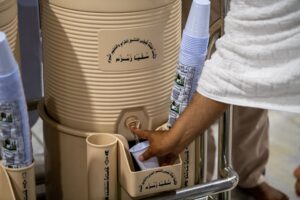
The two Rakaah of Tawaf
- After completing circumambulation, it is Sunnah to pray two Rakaah. This is a confirmed Sunnah for everyone who has circumambulated the Kaaba for Hajj or Umrah, or who performed an absolute supererogatory circumambulation.
- It is prescribed to recite Surat Al Kafirun in the first Rakaah, and Surat Al Ikhlaas in the second one. Because circumambulation is the symbol of monotheism and the worship of Allah alone, Who has no partner; it is prescribed for a person to announce that in the recited Surat that one recites upon completing circumambulation.
- If it is not too difficult for him/her, it is Sunnah to perform this prayer of two Rakaah behind Maqam Abrahim, so that the Maqam will be between him/her and the Kaaba. One must pray where security officers advise doing so. The two Rakaah of Tawaf can be performed anywhere in the Grand Mosque, but the people who are circumambulating have more right to the space around the Kaaba than people performing their prayer.

The Messenger of Allah (blessings and peace be upon him) practiced some ways during the circumambulation. His companions followed him in this respect, as he (blessings and peace be upon him) said: “Learn your Hajj rituals from me”.
The circumambulation, as is the case with the rest of the acts of Hajj and Umrah, is one of the great acts of worship in which Muslims strive to follow the example of the Messenger of Allah (blessings and peace be upon him). This is a great reason for Allah’s love for His servants, as the Almighty said: {Say: If you love Allah, follow me, and Allah will love you and forgive your sins. Allah is All-forgiving, All-compassionate}.
Circumambulation prophetic ways include
Takbir
- It is Sunnah for those who are in line with the Black Stone or the Green Light in the upper floors at the beginning and end of each round to raise their hands and say: “Allaahu Akbar”.
Supplication
- The circumambulation of the Kaaba is one of the greatest occasions of supplication to Allah. The Messenger of Allah (blessings and peace be upon him) used to fill every moment of his circumambulation with supplication and remembrance. He used to say after passing the Yemeni corner (which is the corner immediately preceding the Black Stone): Rabbanaa Aatinaa Fid-Dunyaa Hasanatan Wa Fil Aakhirati Hasanatan Waqinaa Adhaab-An-Naar (O our Lord, give us good in this worldly life and in the Hereafter and protect us from the torment of the Fire).
- A circumambulator supplicates, asking Allah for all his needs and seeks His help in whatever he/she cares about in this world and the Hereafter, in his native tongue, for the greatest supplication is that in which the heart and tongue agree.
- The greatest and most blessed supplications are those mentioned in the Quraan and the supplications of the Messenger of Allah (blessings and peace be upon him).
Idtibaa
- It is a Sunnah for men to uncover their right shoulder when performing circumambulation for Umrah, following the example of the Prophet (blessings and peace be upon him). This practice applies only to the Umrah circumambulation and that of Qudoom
Al Ramal
- It is Sunnah for men, if possible, to speed up and walk briskly with small steps in the first three rounds, following the example of the Messenger of Allah (blessings and peace be upon him). Then they complete the remaining four rounds by walking at a normal pace in the Tawaf of Umrah and Qudoom
Praying two Rakaah after the circumambulation
- It is Sunnah to pray two Rakaah after completing the circumambulation, and to recite Surat Al Kafirun in the first Rakaah and surat Al Ikhlas in the second
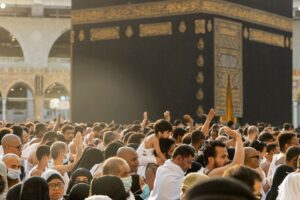
The circumambulation area is the courtyard tiled with white marble, which surrounds the Noble Kaaba. It is now called the courtyard. It is the space where Muslims rotate around the Kaaba.
Some important features of the circumambulation courtyard are:
The Noble Kaaba
- It is the Qiblah of Muslims and is dear to their hearts. It is the only object around which they rotate in worship to Allah.
Maqam Ibrahim (Abraham)
- It is the rock on which Abraham, peace be upon him, stood when building the Kaaba. It is a clear and visible sign in Haram. Allah Almighty said: {In it are clear signs such as the standing place of Abraham}.
The Maqam of Abraham is the stone on which Abraham, peace be upon him, stood to build the Kaaba.
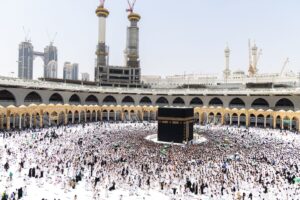
There are many licensed barbershops around the Grand Mosque to shave off the head hair of Hajj and ‘Umrah pilgrims. These shops are equipped for a safe shave in a healthy environment.
At the barbershop, make sure that a barber
- Uses a single-use disposable razor
- Disposes of used tools and uses new ones
- Washes his hands with soap and water before starting the shave

There are many licensed barbershops around the Grand Mosque to shave off the head hair of Hajj and ‘Umrah pilgrims. These shops are equipped for a safe shave in a healthy environment.
At the barbershop, make sure that a barber
- Uses a single-use disposable razor
- Disposes of used tools and uses new ones
- Washes his hands with soap and water before starting the shave

What are Safa and Marwa?
- Safa and Marwa are two small hills on which Ismail’s mother, Hagar, climbed in search of food or water.
Safa
- It is a small hill from which Sa’i begins. The rocks of the hill are still visible on the ground floor there.
Marwa
- It is a small hill where the round of Sa’i ends.
Sa’i is an important rite
- Performing Sa’i between Safa and Marwa is a ritual of Hajj and Umrah alike. Allah the Exalted said: {Indeed, Safa and Marwa are among the symbols of Allah. So whoever makes Hajj to the House or performs Umrah – there is no blame upon him for walking between them}.
- The pilgrim performing Hajj or Umrah worships his Lord by crossing the distance between Safa and Marwa seven times, as did his Noble Messenger (blessings and peace be upon him).
The beginning and end of Sa’i
- You start your Sa’i from Safa, heading towards Marwa. Upon reaching Marwa, you have completed one round. Crossing the distance back to Safa fulfills the second round, and so on, until the seventh-round ends at Marwa.
Supplication at the beginning of Safa and Marwa
- When you arrive at the beginning of Safa and Marwa, it is Sunnah to raise your hands, face the Qiblah and supplicate to Allah, saying: “Allahu Akbar” before starting a new round.
The two green signs
- It is recommended for capable men to run between the two green signs, following the example of the Messenger of Allah (blessings and peace be upon him).
Supplication during Sa’i
- A pilgrim should fill the entire time of his Sa’i with remembrance and supplication to Allah or with reciting the Quran.
The Prophet’s supplication during Sa’i
- When the Messenger of Allah (blessings and peace be upon him) first reached Safa after the circumambulation, he would recite this part of the Quranic Ayah {Indeed, Safa and Marwa are among the symbols of Allah}, and would add: {Begin with what Allah began with}.
- When climbing up Safa and Marwa, the Prophet (blessings and peace be upon him) used to face the Qiblah and recite: “Allah is the greatest. Allah is the greatest. There is no true god but Allah alone. He has no partner. His is the Sovereignty, to Him praise is due and He is powerful over everything. There is no true god but Allah alone. He fulfilled His promise, helped His servant to victory, and alone routed the Confederates”. After that he shall supplicate with whatever he wishes, repeat the above remembrance, and proceed with Sa’i.
The person performing Sa’i should not stop to say prayers in a place if that disrupts the flow of pedestrians and causes crowding. He must adhere to the instructions of security personnel in the sanctuary.
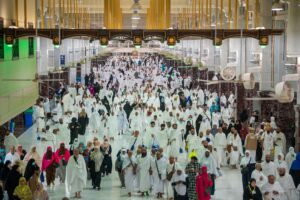
It is prescribed to shave or shorten the hair of the head in the worship of Allah after the rituals of pilgrimage have been completed, just as the person in Ihram used to worship Allah by not shaving his hair; in both cases, he is a worshipper of Allah and submits to Him.
Shaving and trimming hair during Hajj
- This happens after stoning Jamrat Al Aqabah on the Day of Sacrifice (Eid).
Shaving and trimming hair during Umrah
- This happens after completing the circumambulation and Sa’i.
Shaving and trimming for men
- It is prescribed for male pilgrims performing Hajj or Umrah to completely have the hair of their head shaven, or shorten all, or most of the hair on their head, the former is better.
Women can only cut a little of their hair
- A woman can only shorten her hair, whether she performs Hajj or Umrah. She gathers her hair and cuts 1-2 cm of it.
Please note
- Pilgrims performing Hajj or Umrah should only have their hair shaved in the places designated for that in order to keep the Haram clean and unpolluted.
A person who is unable to walk due to disability, tiredness, illness, or old age may perform Sa’i while riding, and he must remain awake and attentive because he is involved in an act of worship. He should fill his time with supplication to Allah, say Takbir, and supplicate whenever he reaches Safa or Marwa.
Various types of wheelchairs are available for circumambulation
Wheelchairs for Pilgrims
- A pilgrim having a wheelchair is allowed to use it provided that he uses the gates designated for people with disability
Free Wheelchairs
- Free wheelchairs are available for pilgrims performing Hajj or Umrah if one has someone to help them during Sa’i
These wheelchairs can be accessed at the following points
- Eastern square (bus entry gate)
- Southern square (next to Endowment of King Abdulaziz)
- Western square (Shubaikah Gate)
Pushing Wheelchair Service
- These are young men trained to push the wheelchaired people
Service Points
- The ground floor of the Tawaf yard (starting line) (Link to website)
- The ground floor of the Tawaf yard (Gate 14)
- The second floor of the Tawaf yard (the Al-Arqam Escalators)
- Endowment of King Abdul Aziz
Electric Wheelchairs
- These are safe power wheelchairs that are easy to drive and control during circumambulation and Sa’i
- There are two types: one-person and two-person electric wheelchairs
Service Access Points
- Electric wheelchairs are located on the first Mezzanine floor of circumambulation and Sa’i
What are Safa and Marwa?
- Two hills that Hagar (mother of Ismail, peace be upon him) climbed in search of food and water
- Safa: a hill at which Sa’i begins. Its rocks are still visible on the ground floor of Al Masaa
- Marwa: a hill opposite Safa at which Sa’i ends
Al Masaa in Figures
- Length: 394 m
- Total walking distance of the seven rounds: approximately 2,761 m
- Average time to complete Sa’i: 45-55 minutes. Walking speed varies depending on several factors
Al Masaa Floors
Al Masaa comprises several floors, with a total area of 87,000 square meters. Those floors are:
- Basement
- Ground floor
- The Mezzanine Floor for electric wheelchairs
- 1st floor
- 2nd floor
- Al Masaa roof
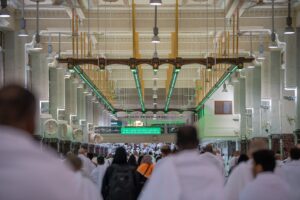
- When you finish the circumambulation, you will see guide signs inside the Grand Mosque that guide you to Al Masaa, and point to Safaa where you should start Sa’i.
- It is advisable to go to Al Masaa on the upper floors in order to avoid crowding on the ground floor so as to make Sa’i easier for everyone.
- A person performing Sa’i should occupy himself all the time with the remembrance of Allah and supplicating Him or reading the Quran. He should not stop to pray in a place where he obstructs movement and causes crowding. He must adhere to the instructions of the security and regulation personnel in Haram.
- Speeding up during Sa’i for men is only applicable between the two green flags, and not throughout the duration of Sa’i.
- If the iqamah for prayer is being established, those performing Sa’i should stop and pray with the congregation, and then resume their Sa’i from where they have left off.
- If you are diabetic, start Sa’i only after taking sufficient medications and food. Try to keep your feet unharmed. You should rest when you feel your blood sugar drops.
- You can use a wheelchair if you feel ill or tired.
- Beware of polluting the sanctuary by cutting hair inside the place of Sa’i. There are many barbershops near the Sanctuary.
